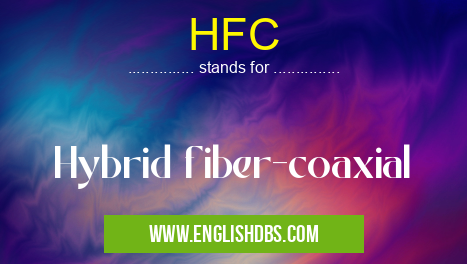What does HFC mean in COMPUTING
Hybrid fiber-coaxial (HFC) is a telecommunications technology that combines fiber optic cables and coaxial cables to provide broadband services. It is commonly used by cable television providers to deliver high-speed internet, cable television, and telephone services to homes and businesses.

HFC meaning in Computing in Computing
HFC mostly used in an acronym Computing in Category Computing that means Hybrid fiber-coaxial
Shorthand: HFC,
Full Form: Hybrid fiber-coaxial
For more information of "Hybrid fiber-coaxial", see the section below.
How HFC Works
HFC networks consist of a fiber optic backbone that runs from the central office to the neighborhood. From there, coaxial cables extend to individual homes and businesses. The fiber optic backbone carries high-bandwidth data signals, while the coaxial cables distribute these signals to end users.
Advantages of HFC
- High-speed internet: HFC technology supports internet speeds up to several gigabits per second (Gbps). This makes it suitable for streaming video, online gaming, and other bandwidth-intensive applications.
- Reliable: Fiber optic cables are less susceptible to interference and signal loss than copper cables, resulting in reliable and consistent performance.
- Cost-effective: HFC networks can leverage existing coaxial infrastructure, making them a cost-effective solution for providing broadband services.
- Scalability: HFC networks can be easily upgraded to higher speeds by upgrading the fiber optic backbone or adding additional coaxial cables.
Applications of HFC
HFC is primarily used for:
- Cable television: HFC delivers cable television signals to homes and businesses.
- High-speed internet: HFC provides high-speed internet access to subscribers.
- Telephone services: HFC can also be used to provide voice over IP (VoIP) telephone services.
Essential Questions and Answers on Hybrid fiber-coaxial in "COMPUTING»COMPUTING"
What is HFC (Hybrid Fiber-Coaxial)?
HFC is a telecommunications technology that combines fiber optic cables and coaxial cables to deliver high-speed broadband internet, voice, and video services to homes and businesses.
How does HFC work?
HFC networks use fiber optic cables to carry signals from a central office to a neighborhood node. From there, coaxial cables distribute the signals to individual homes and businesses. This hybrid approach allows for faster speeds and greater bandwidth than traditional coaxial cable networks.
What are the benefits of HFC?
HFC offers several benefits over traditional coaxial cable, including:
- Faster speeds: HFC can support download speeds of up to 1 gigabit per second (Gbps) and upload speeds of up to 100 megabits per second (Mbps).
- Increased bandwidth: HFC provides a wider range of frequencies than coaxial cable, allowing for more simultaneous connections and bandwidth-intensive activities.
- Improved reliability: Fiber optic cables are less susceptible to signal interference and damage than coaxial cables, resulting in a more reliable connection.
- Future-proof technology: HFC is a scalable technology that can be upgraded to support even higher speeds and bandwidth in the future.
What are the drawbacks of HFC?
HFC has a few drawbacks to consider:
- Limited availability: HFC networks are not as widely available as traditional coaxial cable networks.
- Cost: HFC installations can be more expensive than coaxial cable installations.
- Latency: HFC networks can have higher latency than fiber-to-the-home (FTTH) networks, which can affect online gaming and other real-time applications.
Is HFC better than coaxial cable?
HFC offers several advantages over traditional coaxial cable, including faster speeds, increased bandwidth, improved reliability, and future-proof technology. However, HFC networks are not as widely available and can be more expensive to install. Ultimately, the best choice for your needs depends on your specific requirements and availability.
Final Words: HFC is a widely used telecommunications technology that combines fiber optic and coaxial cables to provide high-speed broadband services. It offers advantages such as high speed, reliability, cost-effectiveness, and scalability, making it a suitable choice for delivering broadband services to residential and business customers.
HFC also stands for: |
|
| All stands for HFC |
